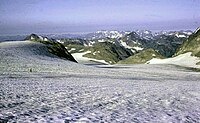
Photo from wikipedia
The classic model of fjord renewal is complicated by tidewater glacier fjords, where submarine melt and subglacial discharge provide substantial buoyancy forcing at depth. Here we use a suite of… Click to show full abstract
The classic model of fjord renewal is complicated by tidewater glacier fjords, where submarine melt and subglacial discharge provide substantial buoyancy forcing at depth. Here we use a suite of idealized, high-resolution numerical ocean simulations to investigate how fjord circulation driven by subglacial plumes, tides, and wind stress depends on fjord width, grounding line depth, and sill height. We find that the depth of the grounding line compared to the sill is a primary control on plume-driven renewal of basin waters. In wide fjords the plume exhibits strong lateral recirculation, increasing the dilution and residence time of glacially-modified waters. Rapid drawdown of basin waters by the subglacial plume in narrow fjords allows for shelf waters to cascade deep into the basin; wide fjords result in a thin, boundary current of shelf waters that flow toward the terminus slightly below sill depth. Wind forcing amplifies the plume-driven exchange flow; however, wind-induced vertical mixing is limited to near-surface waters. Tidal mixing over the sill increases in-fjord transport of deep shelf waters and erodes basin stratification above the sill depth. These results underscore the first-order importances of fjord-glacier geometry in controlling circulation in tidewater glacier fjords and, thus, ocean heat transport to the ice.
Journal Title: Journal of Geophysical Research
Year Published: 2017
Link to full text (if available)
Share on Social Media: Sign Up to like & get
recommendations!